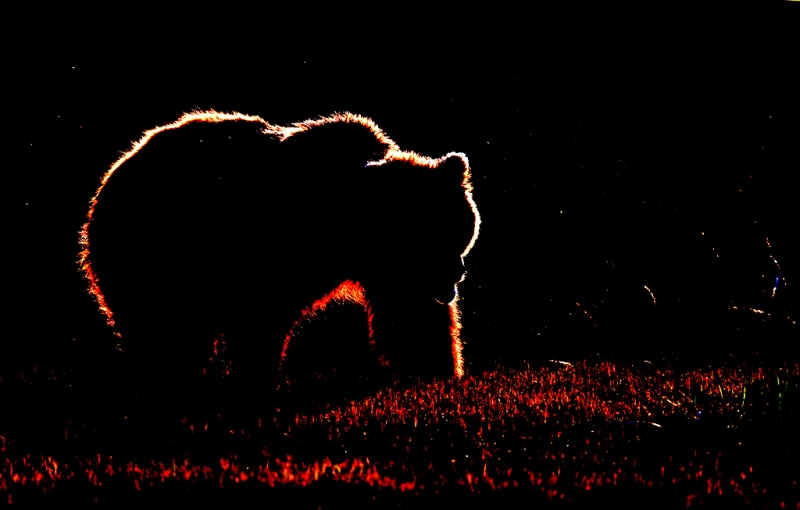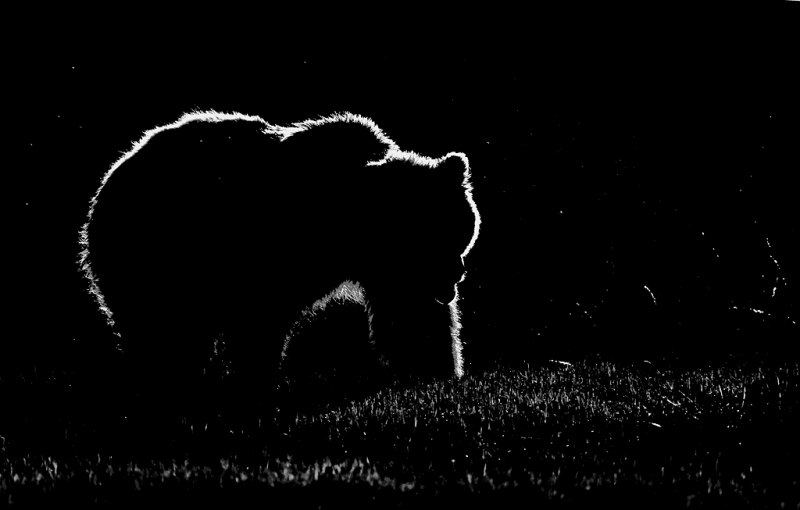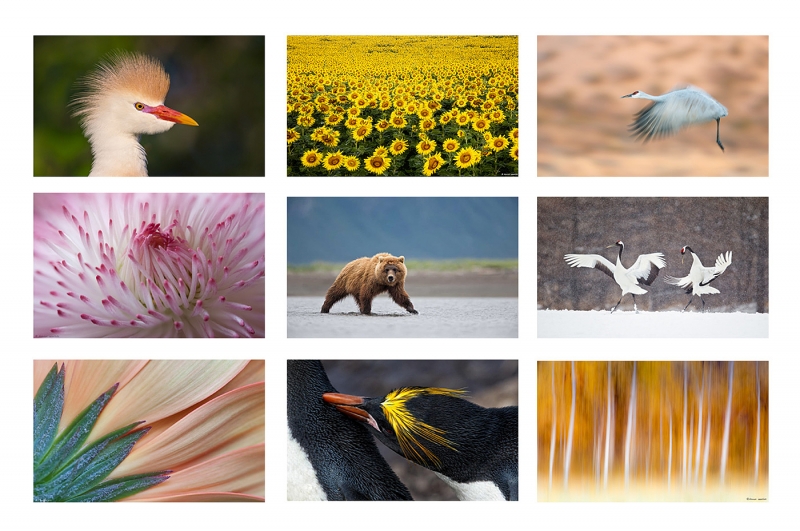|
This Coastal Brown Bear image was created in Katmai National Park on a 2009 Bear Boat IPT with the tripod-mounted Canon EF 800mm f/5.6L IS USM Autofocus lens, the Canon 1.4x EF Extender III (teleconverter), and the discontinued EOS-1D Mark IV that has been replaced by the Canon EOS-1D X digital SLR . ISO 640. Evaluative metering -1/3 stop: 1/200 sec. at f/9. Central sensor (by necessity)/AI Servo/Rear Focus AF on the rim light and re-compose. Click here if you missed the Rear Focus Tutorial. Click on the image to see a larger version. |
Blacklight
I came across the image above while reviewing some old image files. I never thought much of it before yesterday but today I am really liking it. I’d love to hear your thoughts. Do you like it? Why? Do you hate it? Why? Somewhere in between? Why? Anything you would have done differently? Why?
Do let me know which version you prefer, the original above or the black and white version below. The B&W version was created in NIK Silver Efex Pro with the Soft Skin pre-set. I gotta be honest, it took me about 15 minutes in Silver Efex Pro trying to decide which preset looked best. I tried several of my faves, Neutral, High Structure, several of the High Contrast Color Filters, and Wet Rocks. All but the latter looked great. Then I tried some of the funkier pre-sets including Darken Contrast Vignette, Soft Skin, Holga, Overexpose EV +1, Infrared Film Soft, and several others. Each of those looked great and each was slightly different. I wound going with the Soft Skin look below.
|
This is the version that I created using the Soft Skin preset in NIK Silver Efex Pro. |
Creativity
For years I have been saying that one of the very best ways to improve your creativity is to look at as many great images as you can in books, on line at websites like BPN, and at slide programs and seminars. I practice what I preach. The first time I saw the words blacklight and blacklit they were used in Andy Rouse’s fine book, Concepts in Nature. My Sally Lightfoot/breaking wave/black lava rock image that was honored in a recent Nature’s Best contest and made the finals of a BBC contest was inspired by a film image from that book. And Andy’s blacklit lion image planted the seed for the bear image presented here.
At one time we carried Concepts in Nature in the BAA On-line store but if you would like to get inspired you will need to get your copy by clicking on the link below.
NIK 15% Discount
As regular readers know, Color Efex Pro has drastically changed my digital workflow and little by little I have begun using Viveza to solve sticky image optimization problems and Silver Efex Pro fo fast, dramatic B&W conversions. You can save 15% on all NIK products (including Color Efex Pro, Silver Efex Pro, and Viveza) by clicking here and entering BAA in the Promo Code box at check-out. Then hit Apply to see your savings. You can download a trial copy that will work for 15 days and allow you to create full sized images.
Bear Boat/Bears Catching Salmon IPT: September 2-9, 2013 from Kodiak, AK: $6699. Happy campers only! Maximum 6 + two leaders: Arthur Morris and Denise Ippolito.
Limit: 6. Openings: 1
I have room for just one male photographer who likes bears and/or an interested female photographer who likes bears and who might consider limited lodging options on the boat, i.e., learn about the rabbit hole. If either of the above describes you, please e-mail. The rabbit hole is not that bad. I have stayed in it myself. There are already two women on this trip, plus Denise.
It is mandatory that you be in Kodiak no later than the late afternoon of September 1 to avoid missing the float plane(s) to the boat on the morning of September 2. With air travel in AK being what it is, with the chance of fog or other bad weather–being on Kodiak on August 31 is an even better plan). I will take the group out to dinner in Kodiak on the evening of September 1. Denise and I will plan on being on Kodiak on August 31 to avoid any potential disaster. We will take one or more float planes to the boat mid-morning on September 2. We will photograph bears that afternoon and every day for the next six days (weather permitting of course). We should have bears catching salmon every day. In addition, we will get some nice stuff on Mew Gull and Glaucous-winged Gulls dining on roe and the remains of predated salmon. we may–depending on where the concentrations of bears are–get to photograph Harbor seals and some hauled out Steller’s Sea Lions (an endangered species). Halibut fishing (license required) is optional. On September 9, our last morning on the boat, we will photograph in the early morning and then return to Kodiak via float plane. The eight days will consist of six full days (Sept 3, 4, 5, 6, 7, & 8) of photography featuring lots of Coastal Brown Bears catching salmon as above plus a variety of other natural history subjects plus some nice scenic photography that I forgot to mention above. Plus the first afternoon and the last morning.
What’s included? 8 DAYS/7 NIGHTS on the boat as above. All meals on the boat. (The food is quite excellent.) National Park fees. One night’s double occupancy lodging on Kodiak; arrive: Sept 1/depart: Sept 2. The thank-you-in-advance dinner on Sept 1. In-the-field photo tips, instruction, and guidance. An insight into the minds of two top professionals; we will constantly let you know what we are thinking, what we are doing, and why we are doing it. Small group image review, image sharing, and Photoshop instruction on the boat. Denise’s creativity will amaze you.
What’s not included: Your round trip airfare to and from Kodiak, AK (almost surely through Anchorage). All necessary lodging other than the cost of your double occupancy room on the night of August 31 should you opt to arrive early–we can arrange that in advance for you. We will let you know the cost of a single supplement if so desired. The cost of the round-trip float plane to the boat on September 2 and back to Kodiak on September 9. The cost of a round trip this year was $500. The suggested crew tip of $210.
Is this an expensive trip? Yes, of course. But with 6 full and two half days, a wealth of great subjects, and the fact that you will be walking with the bears it will be one of the great experiences of your life. (See the comments below.) Most folks who take part in a Bear Boat IPT wind up coming back for more. A $2,000 per person non-refundable deposit by check only made out to “Arthur Morris” is required to hold your spot. Please click here and then scroll down and read our cancellation policies. Then please print, read, and sign the necessary paperwork here and send it to us with your deposit check. Deposit due immediately. That leaves a balance of $4499. The first payment of $2499 is due January 15, 2013. The final payment of $2000 is due on April 15, 2013. This trip is a go. Note: most similar but cheaper trips are only 7 DAYS/6 NIGHTS. Please e-mail for photos.
Arctic Pro Muck Boots
On my first trip to the Southern Oceans in 2007, I ordered a pair of Arctic Pro Muck Boots on the advice of many. I returned them and went with too-large and too-heavy neoprene waders. For my two 2012 trips I ordered a pair of Arctic Pro Muck Boots. I got them large enough to wear with one pair of heavy socks and one pair of regular socks. Wow! My feet were always dry and always warm. They were tall enough for all the wet landings, even those in heavy surf. This year I wore them at Bosque. My always cold feet were never cold. Last week I wore them on the Barnegat Jetty. Never cold at all. They enabled me to stand in the saltwater pools next to the jetty on the crazy wind-driven high tides that we encountered. And on the jetty, they provided firm footing at all times. (Warning: unless you have ice creepers, never walk on black, dark green, slimy jetty rocks….)
Weekend Creative Nature Photography Seminar, Tampa, FL: February 23 & 24, 2013: $149 Limit: 50/Openings: 20
Join Denise Ippolito and me on the weekend of February 23-24 on the outskirts of Tampa, FL for a great weekend of fun and learning. Learn to improve your photography skills, your skill at designing images in the field, your creative vision, and your image optimization skills. Sunday critiquing session. Click here for additional details and the complete schedule.
Best to register soon as the seminar is filling up nicely.
Support the BAA Blog. Support the BAA Bulletins
We want and need to keep providing you with the latest free information, photography and Photoshop lessons, and all manner of related information. Show your appreciation by making your purchases immediately after clicking on any of our B&H (or Amazon.com) Affiliate links in this blog post. Remember, B&H ain’t just photography!


Shop Amazon
You can find other types of Muck Boots by simply typing “muck boots” in the little white box below and hitting Go. Thanks!

















Really like the B&W!
In today’s blog, blacklight is clearly used as a variant of backlit.
When I tried my hand as a art dealer (disastrously) for a few years in the early 1980s I learned about ultraviolet light, aka blacklight, which was used to expose recent restorations on old paintings. So for me the term blacklight as Artie and presumably others use it, is confusing. You all have adopted it, which is fine. But I’d be curious to hear if anyone else has raised the subject.
John, Great comment. I answered it here.
Definitely the black and white one. Nice!
Sarah
I would prefer the first one but with the reds toned down to look sunsetty (new word) rather than garish.
I love the first one. To me it is most natural, and it requires curiosity. I can tell that the second one has been changed. I like natural when photographing nature and wildlife.
I prefer the black-and white version. I like the bear in both, but I defintely do not like the red grass! it makes the picture very artificial looking.
Ruthie
I prefer the B&W as the color doesn’t add to the impact for me. Love the full outline of the bear and that you can tell the mouth is agape. If mine I’d stamp out the miscelaneous highlights above the grass line and surrounding the bear.
Artie, I like the play on words with the use of “blacklight”. I love the first one! The color adds impact. I do think that the B&W one could be as dynamic if you added a little more light to the grasses at the bottom.
I like both for the drama they seem to convey but I favor the B&W slightly,,,,also shouldn’t it be BACKLIGHT instead of BLACKLIGHT?
I was coining a new term 🙂 See more here.
I prefer the B&W. Having worked in a old school darkroom 35-45 yrs ago, and done solarizations, contrast outlines, etc. it seems more interpretive and artsy. I would like to see more work on the change zones, maybe get some detail into the face/muzzle area and delete the distractions. In the colored variation I find the transition zones to abrupt for the colors. Nice job.
I like the first version it has,to me more drama like it is on fire, but I also like the second version it appears to me to be moon lit, softer and very applealing. I am not sitting on the fence, I do like them both, for the different reasons I have stated.
I like the top one. The main reason is the bear just outside of the light on the ground. It has me anticipating the next step and possibly seeing the head. The other thing is the nose. If the bear would’ve turned his just a little more right, the nose probably would’ve been lost. But the way it is now, I can see the shape.
Then moving down, to the mouth, there’s just enough back light to give that shape. Again, if the bear looked right or you moved to the right, that too would’ve been
lost. The one thing I might do is remove the little spots of light (if that’s what that is) on the main body of the bear itself. Doug